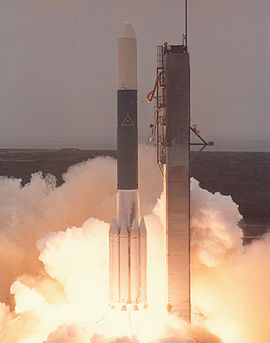Delta 3000

Launch of SolarMax on a Delta 3910 7.2-J 6900.1
|
|
| Function | Expendable launch system |
|---|---|
| Country of origin | United States |
| Launch history | |
| Status | Retired |
| Launch sites |
Canaveral LC-17 Vandenberg SLC-2W |
| Total launches | 38 |
| Successes | 35 |
| Failures | 2 |
| Partial failures | 1 |
| First flight | 13 December 1975 |
| Last flight | 24 March 1989 |
The Delta 3000 series was an American expendable launch system which was used to conduct 38 orbital launches between 1975 and 1989. It was a member of the Delta family of rockets. Several variants existed, which were differentiated by a four digit numerical code.
The first stage was the RS-27 powered Extended Long Tank Thor, first flown on the 2000-series. Three or nine Castor-4 solid rocket boosters were attached to increase thrust at lift-off, replacing the less powerful Castor-2 boosters used on earlier models. Two second stages were available; the Delta-P, which had been flown on the Delta 1000 and 2000 series, or the Delta-K, an uprated version with the Aerojet engine. Some launches used a three-stage configuration in order to reach higher orbits. A Star-37D, Star-37E, or Star-48B PAM-D could be used as an upper stage. Launches with PAM-D upper stages were designated Delta 3XX0 PAM-D, rather than assigning a code to the upper stage for use in the four-digit sequence. From the 4000-series onwards, the PAM-D received the upper stage code "5", however this was not applied retrospectively to 3000-series rockets, which were still in service at the time.
The Delta 3000 could put a payload of 954 kg (2,103 lb) to a GTO.
The Delta 3000 was launched from Space Launch Complex 2W at Vandenberg AFB and Launch Complex 17A and B at Cape Canaveral. Of the 35 launches, there were two complete and one partial failure. The first, Vehicle 134 lifted from LC-17A at Cape Canaveral on September 13, 1977 with an Italian-built OTS communications satellite. Fifty-two seconds after liftoff, the Delta exploded. Booster and satellite debris were dredged from the sea bottom and it was ultimately discovered that a hairline crack in one SRB motor caused exhaust gas to escape and burn through the Delta's RP-1 tank, igniting the propellant. When the booster had been assembled on the pad the previous May, a handling accident occurred with the SRB motors that apparently damaged one of them. The payload fairing disintegrated at vehicle breakup and the OTS satellite was ripped apart by aerodynamic loads. Parts of the solar panels, batteries, and hydrazine propellant tanks were recovered from the ocean. There had been an upper stage failure of a Delta 2000 series in April and three weeks later, an Atlas-Centaur exploded 55 seconds after liftoff. NASA was particularly vexed by the string of accidents in 1977 because they had had a perfect run the year before (16 launches in 1976 without a failure). While this record (three failures out of 16 NASA launches during 1977) would have been acceptable in the 1960s, it was not welcomed at all in the late 1970s after the early "Wild West" days of the space program had passed and the hardware was supposed to be mature.
...
Wikipedia
